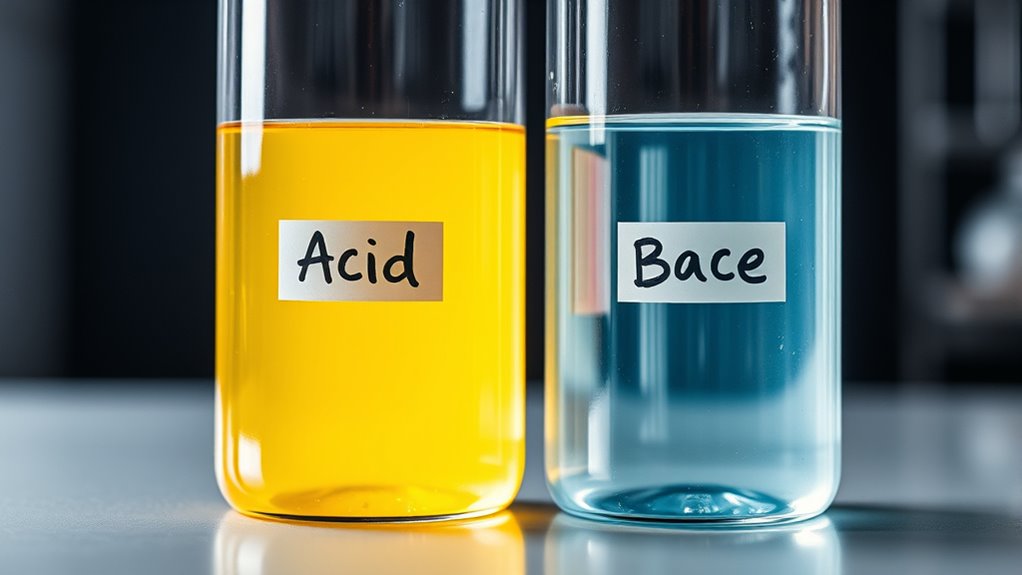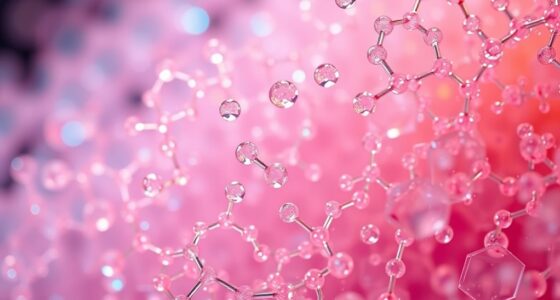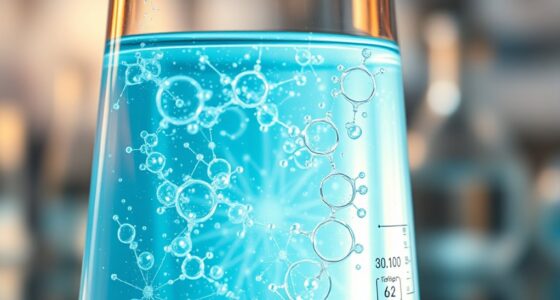Acids are substances that release hydrogen ions (H+) in water, making them taste sour and turn litmus paper red. Bases, on the other hand, release hydroxide ions (OH−), feel slippery, and turn litmus paper blue. You find acids in lemon juice and vinegar, while bases are in baking soda and soap. They react to form salt and water, and different theories explain how they behave. Explore further to understand their many uses and reactions.
Key Takeaways
- Acids are substances that release hydrogen ions (H+) in water, giving them a sour taste and low pH.
- Bases are substances that release hydroxide ions (OH-) in water, often feeling slippery and having a high pH.
- Acids and bases react together to form salt and water in neutralization reactions.
- Examples of acids include lemon juice and vinegar; common bases are soap and baking soda.
- The pH scale measures acidity or alkalinity, with acids below 7 and bases above 7.
What Are Acids and How Do They Work?
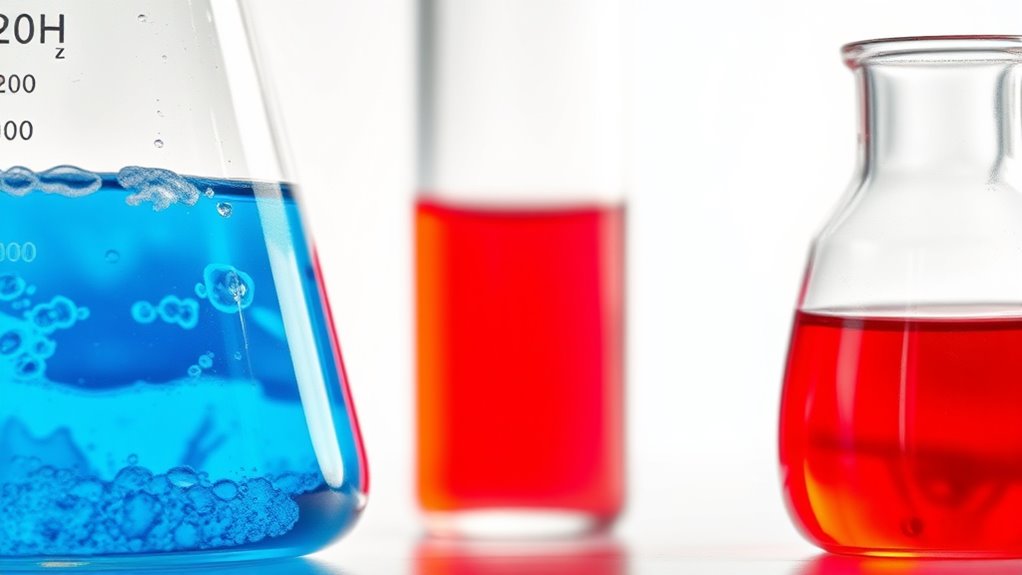
Have you ever wondered what makes a substance an acid and how it interacts with other materials? An acid is a substance that, when dissolved in water, releases hydrogen ions (H+). These ions give acids their sour taste and can change indicator colors, like turning blue litmus paper red.
Acids react with some metals, such as iron and calcium, releasing hydrogen gas. They also react with bases in neutralization reactions, creating salts.
In water, acids have a pH less than 7, with lower pH indicating stronger acids. According to the Arrhenius theory, acids increase H+ concentration in solutions. Acids are also classified as inorganic mineral acids or organic acids based on their composition.
The Brønsted–Lowry theory describes acids as proton donors, while Lewis broadens this view to electron pair acceptance. These behaviors make acids essential in many chemical processes.
Common Examples of Acids and Bases
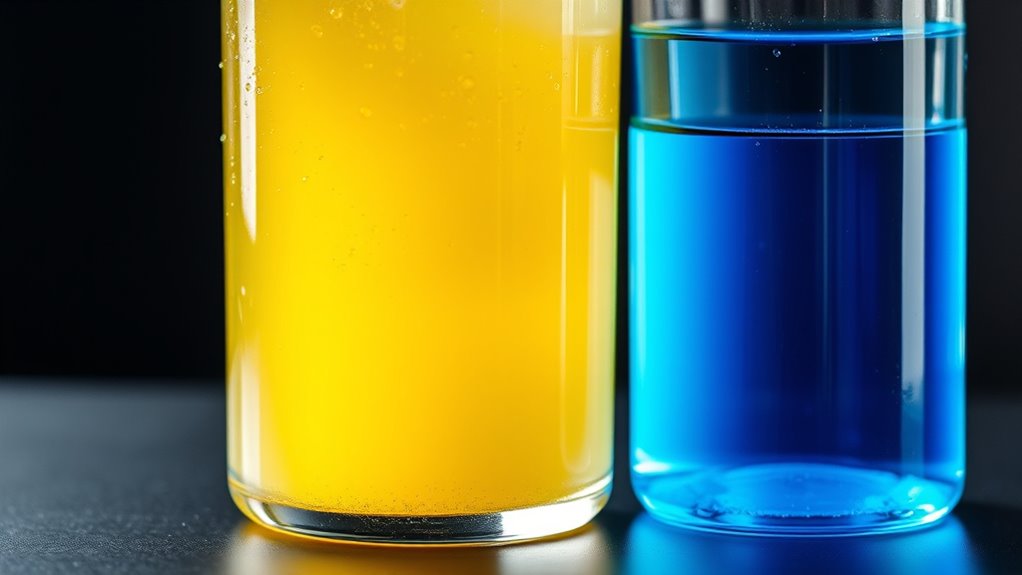
Many common substances around you’re acids or bases, each with distinct properties and uses. For example, stomach acid contains hydrochloric acid (HCl), which helps digest food. Vinegar has acetic acid, used in cooking and food preservation, while citrus fruits like lemons contain citric acid, adding flavor and acting as a preservative. Acids are often found in foods, providing tangy flavors and aiding in preservation. Bases include baking soda (sodium bicarbonate), used in baking and as an antacid, and ammonia, found in household cleaners. Soap and chlorine bleach are strong bases used for cleaning and disinfecting. Every day, items like yogurt contain lactic acid, and soda has carbonic and phosphoric acids, giving tart flavors. Egg whites and milk of magnesia are mildly basic, while pure water and sugar are neutral. These examples show how acids and bases are part of daily life.
How Do Acids and Bases Feel and Look?
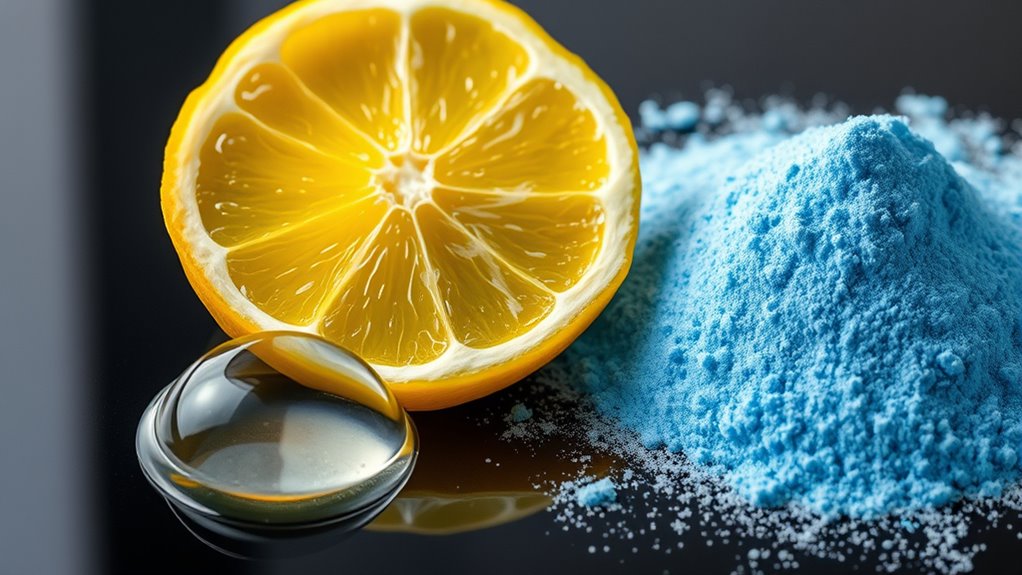
Acids and bases have distinct appearances and textures that can help you identify them safely. Mineral acids are usually colorless liquids, but some, like sulfuric acid, can appear yellow if impure.
Mineral acids are typically clear liquids, though impurities like sulfuric acid may give them a yellow tint.
Organic acids often solidify as white solids, while bases are generally clear liquids or white solids, such as baking soda.
When in aqueous solutions, acids look transparent and clear, whereas bases can be either clear liquids like ammonia or white solids.
Texture-wise, acids tend to feel rough or dry, but strong acids are highly corrosive and dangerous.
Bases typically feel slippery or soapy, similar to soap, because they react with skin oils to form soap-like substances.
Handle both with care to avoid burns or irritation.
How Do Acids and Bases React With Each Other?
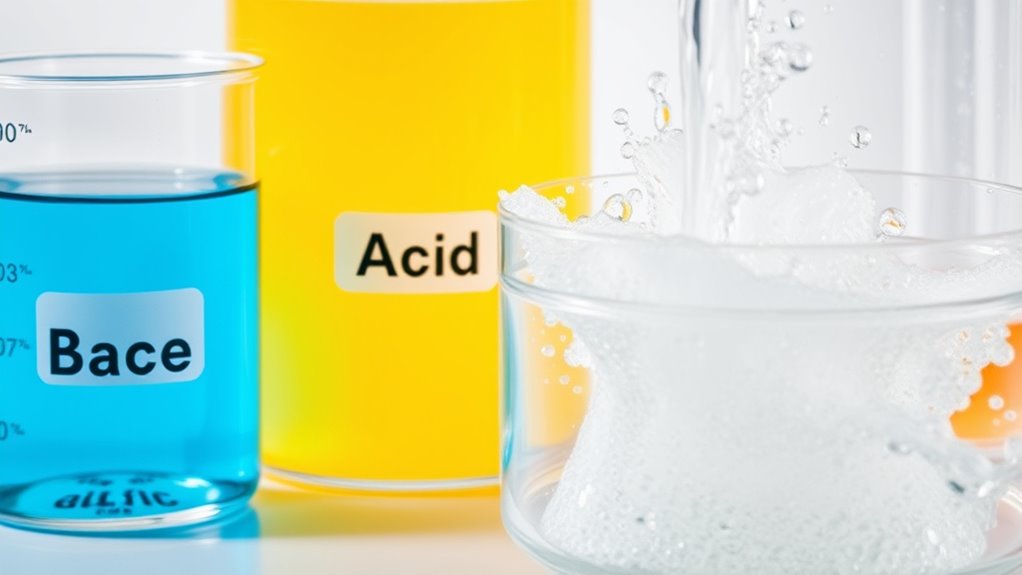
How do acids and bases interact when they come into contact? When they meet, they transfer a proton (H⁺) from the acid to the base. The acid loses a proton, forming its conjugate base, while the base gains the proton, becoming its conjugate acid. This process involves breaking the H–X bond in the acid and forming a new H–Y bond with the base. Electron movement is shown with curved arrows, indicating how lone pair electrons attack the proton. These reactions often produce salt and water, especially in aqueous solutions. The reactions reach equilibrium based on the strengths of the acids and bases involved. Understanding acid-base reactions helps predict whether a reaction will proceed forward or reverse.
Different Theories Explaining Acid-Base Behavior
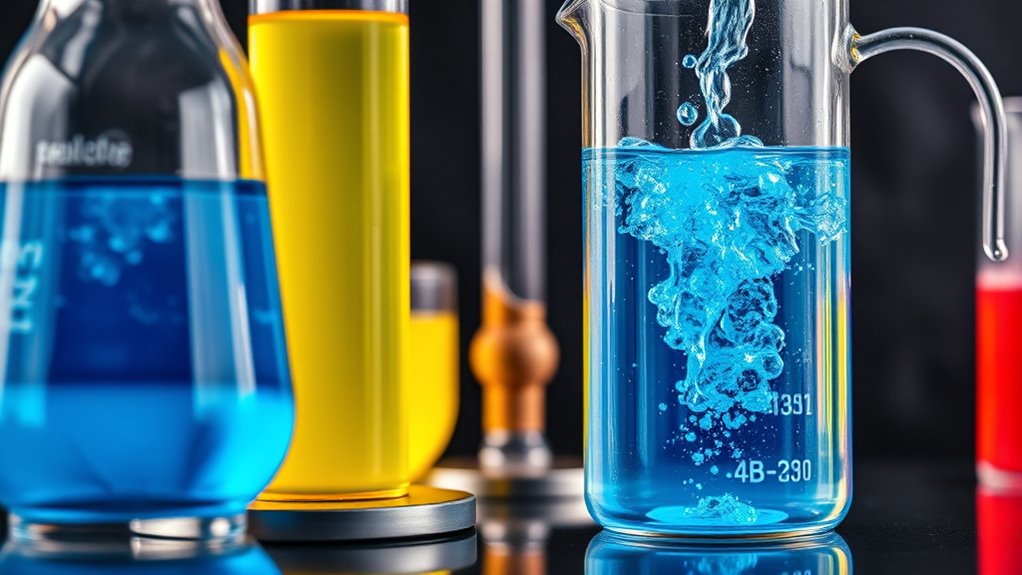
Theories explaining acid-base behavior provide different frameworks for understanding how substances interact beyond simple proton transfer. The Arrhenius theory focuses on acids increasing hydrogen ions and bases increasing hydroxide ions in water, making it useful for common aqueous reactions but limited outside water and gases. The Brønsted-Lowry theory expands this idea, defining acids as proton donors and bases as proton acceptors, which applies to organic and biological systems. Lewis theory goes further by describing acids as electron pair acceptors and bases as donors, covering reactions in gases and complex formations without involving protons. The Usanovich theory broadens the scope by including electron and charge transfer, even redox reactions. Modern models like HSAB and ECW categorize acids and bases based on charge density and polarizability, helping predict interactions more precisely. Understanding different theories provides a comprehensive perspective on acid-base behavior across various chemical contexts.
Everyday Uses of Acids and Bases
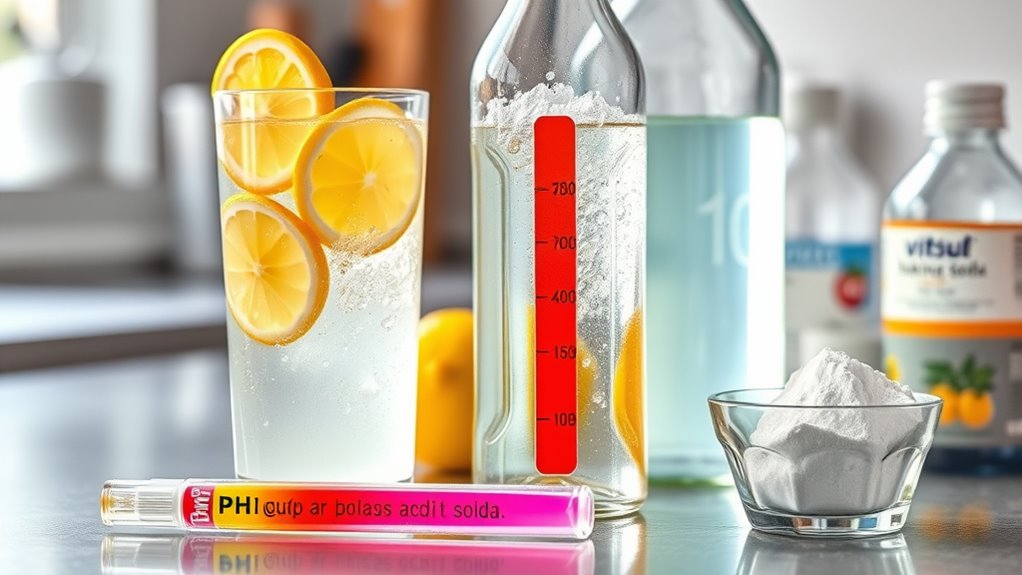
Have you ever wondered how acids and bases are part of your daily life? You encounter them every day in many forms. In cooking, acids like lemon juice and vinegar add flavor and preserve food.
When cleaning, acids in toilet bowl cleaners dissolve grime, while bases in laundry detergents and drain cleaners remove stains. Your toothpaste contains bases like sodium fluoride to strengthen teeth, and antacids with magnesium hydroxide help soothe stomach acid.
Household products such as baking soda, dishwasher detergents, and shampoos also rely on acids and bases. These substances aren’t just common; they’re essential for health, cleaning, cooking, and even environmental protection.
From fertilizing plants to treating wastewater, acids and bases play a crucial role in everyday life. Understanding their properties helps us use these substances safely and effectively in various applications.
Frequently Asked Questions
How Do Acids and Bases Affect Human Health?
You mightn’t realize it, but acids and bases markedly impact your health. An imbalance can disrupt enzyme functions, electrolyte levels, and oxygen delivery, leading to symptoms like fatigue, weakness, or more serious issues like kidney problems.
Consuming too many acidic foods or not enough alkaline ones can throw off your body’s pH. To stay healthy, focus on a balanced diet, hydrate well, and monitor your health regularly.
Can Acids and Bases Be Harmful or Safe to Handle?
You might think acids and bases are safe if handled carefully, but they can be very harmful. Strong acids and bases are corrosive, causing severe burns and tissue damage.
Proper safety measures, like wearing eye protection, gloves, and working in well-ventilated areas, are essential. Even with precautions, accidental exposure can happen.
Always follow safety protocols and be aware of the risks to prevent injuries and manage hazards effectively.
What Are Natural Sources of Acids and Bases?
You’ll find natural sources of acids mainly in fruits and vegetables, like citrus fruits with citric acid and fermented foods containing lactic or acetic acids.
Bases come from minerals in soils, such as limestone, and from microbial activity. Microbes also produce acids during decomposition, while some plants and soils naturally contain alkaline substances.
These sources help maintain the balance of acids and bases in ecosystems and food.
How Does Ph Influence Environmental Systems?
You mightn’t realize it, but pH levels directly influence environmental systems, affecting over 70% of Earth’s ecosystems.
When pH shifts, it alters microbial energy availability, impacting chemical reactions and nutrient cycling.
You’ll see changes in dissolved oxygen and species distribution, which can threaten biodiversity.
Monitoring pH helps you gauge pollution levels and ecosystem health, ensuring that aquatic life and natural processes remain balanced and resilient.
Are All Acids and Bases Dangerous or Toxic?
You might wonder if all acids and bases are dangerous or toxic. In reality, not all are harmful—many household acids and bases are safe when used properly at low concentrations.
The danger increases with stronger, concentrated chemicals, improper handling, or accidental mixing. Always wear protective gear and follow safety protocols, because even mild acids or bases can cause serious tissue damage or health hazards if mishandled.
Conclusion
Now that you know what acids and bases are, you can see how they’re the unsung heroes of your daily life. From the tangy lemon to the soapy water, they’re everywhere, shaping your experiences. Think of them as the yin and yang of chemistry, balancing each other out. Once you understand their dance, you’ll see the world in a new light—where every reaction is a story waiting to be told.
